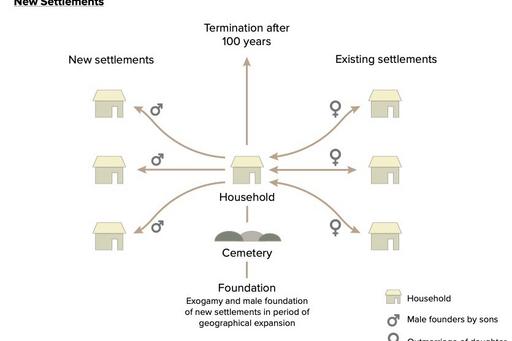- Home
- News and events
- Find news
- Copper Age Kinship and Social Organisation
Copper Age Kinship and Social Organisation
Multiple marriage partners over generations created wide ranging alliance networks for late 3rd millennium BCE Bell Beaker societies in Central Europe.
A newly published cross-disciplinary in-depth study of two family cemeteries of the Bell Beaker Culture has opened a new window to kinship organisation of this period. By combining ancient DNA with isotopic tracing of mobility it was possible to demonstrate that women were moving to get married while men stayed. This principle of exogamy also implied that you should not marry twice into the same family. In this way every community would have, over generations, multiple marriage partners, which helped to create a wide-ranging alliance network, needed for trade and protection. Among the women buried in the two cemeteries 12 kilometers apart there was however no overlap of genetic haplotypes, which suggest that these two communities had marriage alliances in different networks.
Archaeology professor Volker Heyd from Helsinki, who conducted the study together with archaeology professor Kristian Kristiansen, from Gothenburg, tells that ‘This kind of detail only became possible when we could combine archaeology, bio-anthropology, genetics, and strontium and oxygen isotopes – it is like becoming an ethnographer of the past’.
In the study they also compared their results to Indo-European terminologies for marriage and kinship. Professor of historical linguists in Copenhagen, Guus Kroonen, who also participated in the study, explains that ‘The results obtained correspond perfectly well with the kinship system that is reconstructed for the Proto-Indo-European speech community, where young males would start new family units, and female spouses move in from the outside, leaving their own families behind. This study shows how biomolecules can be used to identify social mechanism behind the spread of languages in the past’.
In a kinship-system resembling the ethnographically well-recorded, so-called ‘Omaha’-system, young boys would be placed with their mother’s brother and raised as foster sons, another way of securing family ties and alliances. In one of the cemeteries we had the burial of a young male teenager who according to his strontium isotopes values had been raised in another locality likely as foster son, and had returned before dying and being buried next to his biological father.
In families like these, there would be a constant flow of women marrying into foreign households, and young boys going the opposite direction. It is also well-known that early Indo-European-speaking societies practiced primogeniture, which means that only the oldest son would inherit. It was a way to keep property together, but it also meant that younger sons had to go out to take their future into their own hands by setting up a new household they could lead. This principle thus created a strong motivation for expansion through the foundation of new settlements.
Kinship and social organization in Copper Age Europe. A cross-disciplinary analysis of archaeology, DNA, isotopes, and anthropology from two Bell Beaker cemeteries was published in PlosOne 16 November 2020 (Karl-Göran Sjögren, Iñigo Olalde, Sophie Carver, Morten E. Allentoft, Tim Knowles, Guus Kroonen, Alistair W.G. Pike, Peter Schröter, Keri A. Brown, Kate Robson Brown, Richard J. Harrison, Francois Bertemes, David Reich, Kristian Kristiansen & Volker Heyd)
Link (open access): https://journals.plos.org/plosone/article?id=10.1371/journal.pone.0241278
Contact:
Kristian Kristiansen – Department of Historical Studies, University of Gothenburg, Gothenburg, Sweden. kristian.kristiansen@archaeology.gu.se
Volker Heyd – Department of Cultures / Archaeology, University of Helsinki, Helsinki, Finland. volker.heyd@helsinki.fi
Guus Kroonen – Department of Nordic Studies and Linguistics, University of Copenhagen, Copenhagen, Denmark. guus@hum.ku.dk


